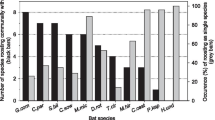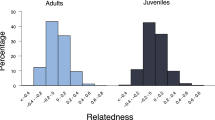Abstract
Kin-based patterns of associations are often observed in group living mammals. Colonies of forest-living big brown bats (Eptesicus fuscus) exhibit fission–fusion roosting behavior and female philopatry. Within a roosting area of forest, adult females are distributed into several subgroups roosting in different trees during the day. At night, adult females leave the roost subgroups to forage and, upon return to the roosting area at dawn, both the individual composition and location of subgroups often change. Individuals exhibit nonrandom roosting associations, and we hypothesized that genetic relationships would influence roosting associations. We determined (1) whether the strength of roosting associations between pairs of bats (based on radiotelemetry) was correlated with relatedness, (2) whether individuals that roosted together in roost subgroups were more related than by chance, and (3) from roost subgroups, the pairs of bats that roosted nonrandomly and whether the proportion of related pairs was higher than expected at random. Relatedness measures were based on microsatellite genotyping and mitochondrial DNA sequences. We found from all analyses that roosting associations were not influenced by relatedness or matrilineal relationships. These results provide clear evidence that, contrary to other mammals, kinship does not mediate roosting associations within forest living big brown bats that exhibit fission–fusion roosting behavior.

Similar content being viewed by others
References
Archie EA, Moss CJ, Alberts SC (2006) The ties that bind: genetic relatedness predicts the fission and fusion of social groups in wild African elephants. Proc R Soc Lond B Biol Sci 273:513–522
Avilés L, Fletcher JA, Cutter AD (2004) The kin composition of social groups: trading group size for degree of altruism. Am Nat 164:132–144
Barclay RMR, Harder LD (2003) Life histories of bats:life in the slow lane. In: Kunz TH, Fenton MB (eds) Bat ecology. The University of Chicago Press, Chicago, pp 209–257
Brigham RM, Brigham AC (1989) Evidence for association between a mother bat and its young during and after foraging. Am Midl Nat 121:205–207
Burland TM, Barratt EM, Nichols RA, Racey PA (2001) Mating patterns, relatedness and the basis of natal philopatry in the brown long-eared bat, Plecotus auritus. Mol Ecol 10:1309–1321
Burland TM, Worthington Wilmer J (2001) Seeing in the dark: molecular approaches to the study of bat populations. Biol Rev 76:389–409
Castella V, Ruedi M (2000) Characterization of highly variable microsatellite loci in the bat Myotis myotis (Chiroptera:Vespertilionidae). Mol Ecol 9:1000–1002
Castella V, Ruedi M, Excoffier L (2001) Contrasted patterns of mitochondrial and nuclear structure among nursery colonies of the bat Myotis myotis. J Evol Biol 14:708–720
de Ruiter JR, Geffen E (1998) Relatedness of matrilines, dispersing males and social groups in long-tailed macaques (Macaca fascicularis). Proc R Soc Lond B Biol Sci 265:79–87
Engh AL, Siebert ER, Greenberg DA, Holekamp KE (2005) Patterns of alliance formation and postconflict aggression indicate spotted hyaenas recognize third-party relationships. Anim Behav 69:209–217
Faulkes CG, Arruda MF, Monteiro da Cruz MAO (2003) Matrilineal genetic structure within and among populations of the cooperatively breeding common marmoset, Callithrix jacchus. Mol Ecol 12:1101–1108
Fumagalli L, Taberlet P, Favre L, Hausser J (1996) Origin and evolution of homologous repeated sequences in the mitochondrial DNA control region of shrews. Mol Biol Evol 13:31–46
Ginsberg JR, Young TP (1992) Measuring association between individuals and groups in behavioural studies. Anim Behav 44:377–379
Hall TA (1999) BioEdit: a user-friendly biological sequence alignment editor and analysis program for Windows 95/98/NT. Nucleic Acids Symp Ser 41:95–98
Holekamp KE, Cooper SM, Katona CI, Berry NA, Frank LG, Smale L (1997) Patterns of association among female spotted hyenas (Crocuta crocuta). J Mammal 78:55–74
Hollis L (2004) Thermoregulation by big brown bats (Eptesicus fuscus): ontogeny, proximate mechanisms and dietary influences. Ph.D. thesis, University of Calgary
Jones KE, MacLarnon A (2001) Bat life histories: testing models of mammalian life-history evolution. Evol Ecol Res 3:465–476
Kalcounis MC, Brigham RM (1998) Secondary use of aspen cavities by tree-roosting big brown bats. J Wildl Manage 62:603–611
Kerth G, König B (1999) Fission, fusion and nonrandom associations in female Bechstein’s bats (Myotis bechsteinii). Behaviour 136:1187–1202
Kerth G, Reckardt K (2003) Information transfer about roosts in female Bechstein’s bats: an experimental field study. Proc R Soc Lond B Biol Sci 270:511–515
Kerth G, Mayer F, Petit E (2002a) Extreme sex-biased dispersal in the communally breeding, nonmigratory Bechstein’s bat (Myotis bechsteinii). Mol Ecol 11:1491–1498
Kerth G, Safi K, Konig B (2002b) Mean colony relatedness is a poor predictor of colony structure and female philopatry in the communally breeding Bechstein’s bat (Myotis bechsteinii). Behav Ecol Sociobiol 52:203–210
Kerth G, Almasi B, Ribi N, Thiel D, Lüpold S (2003) Social interactions among wild female Bechstein’s bats (Myotis bechsteinii) living in a maternity colony. Acta Ethol 5:107–114
Kurta A, Baker R (1990) Eptesicus fuscus. Am Soc Mammal Mammal Species 356:1–10
Lausen CL, Barclay RMR (2003) Thermoregulation and roost selection by reproductive female big brown bats (Eptesicus fuscus) roosting in rock crevices. J Zool 260:235–244
Lukas D, Reynolds V, Boesch C, Vigilant L (2005) To what extent does living in a group mean living with kin? Mol Ecol 14:2181–2196
Manly BFJ (1991) Randomization and Monte Carlo methods in biology. Chapman and Hall, London
Marshall T, Slate J, Kruuk L, Pemberton JM (1998) Statistical confidence for likelihood-based paternity inference in natural populations. Mol Ecol 7:639–655
Maurer BA, Brown JH, Dayan T, Enquist BJ, Ernest SKM, Hadly EA, Haskell JP, Jablonski D, Jones KE, Kaufman DM, Lyons SK, Niklas KJ, Porter WP, Roy K, Smith FA, Tiffney B, Willig MR (2004) Similarities in body size distributions of small-bodied flying vertebrates. Evol Ecol Res 6:783–797
O’Donnell CFJ (2000) Cryptic local populations in a temperate rainforest bat Chalinolobus tuberculatus in New Zealand. Anim Conserv 3:287–297
O’Farrell MJ, Studier EH (1973) Reproductive, growth, and development in Myotis thysanodes and M lucifugus (Chiroptera:Vespertilionidae). Ecology 54:18–30
Packer C, Pusey AE, Eberly LE (2001) Egalitarianism in female African lions. Science 293:690–693
Queller DC, Goodnight KF (1989) Estimating relatedness using genetic markers. Evolution 43:258–275
Racey P, Swift S (1981) Variation in gestation length in a colony of pipistrelle bats (Pipistrellus pipistrellus) from year to year. J Reprod Fertil 61:123–129
Raymond M, Rousset F (1995) GENEPOP (version 1.2): population genetics software for exact tests and ecumenicism. J Heredity 86:248–249
Rhodes M, Grant W, Wardell-Johnson MP, Rhodes BR (2006) Applying network analysis to the conservation of habitat trees in urban environments: a case study from Brisbane, Australia. Conserv Biol 20:861–870
Rice WR (1989) Analyzing tables of statistical test. Evolution 43:223–249
Rossiter SJ, Jones G, Ransome RD, Barratt EM (2002) Relatedness structure and kin-biased foraging in the greater horseshoe bat (Rhinolophus ferrumequinum). Behav Ecol Sociobiol 51:510–518
Rossiter SJ, Ransome RD, Faulkes CG, Le Comber SC, Jones G (2005) Mate fidelity and intra-lineage polygyny in greater horseshoe bats. Nature 437:408–411
Russo D, Cistrone L, Jones G (2005) Spatial and temporal patterns of roost use by tree-dwelling barbastelle bats Barbastella barbastellus. Ecography 28:769–776
Silk JB (2002) Kin selection in primate groups. Int J Primatol 23:849–875
Silk JB, Altmann J, Alberts SC (2006a) Social relationships among adult female baboons (Papio cynocephalus) I. Variation in the strength of social bonds. Behav Ecol Sociobiol 61:183–195
Silk JB, Alberts SC, Altmann J (2006b) Social relationships among adult female baboons (Papio cynocephalus) II. Variation in the quality and stability of social bonds. Behav Ecol Sociobiol 61:197–204
Smith VA, King AP, West MJ (2002) The context of social learning: association patterns in a captive flock of brown-headed cowbirds. Anim Behav 63:23–35
Thomas DW, Dorais M, Bergeron JM (1990) Winter energy budgets and the cost of arousals for hibernating little brown bats, Myotis lucifugus. J Mammal 71:475–479
Trune DR, Slobodchikoff CN (1978) Position of immatures in pallid bat clusters: a case of reciprocal altruism? J Mammal 59:193–195
Van Horn RC, Engh AL, Scribner KT, Funk SM, Holekamp KE (2004) Behavioural structuring of relatedness in the spotted hyena (Crocuta crocuta) suggests direct fitness benefits of clan-level cooperation. Mol Ecol 13:449–458
van Schaik CP (1999) The socioecology of fission–fusion sociality in orangutans. Primates 40:69–86
Vonhof MJ, Davis CS, Strobeck C, Fenton MB (2001) Characterization of microsatellite loci in Spix’s disk-winged bats (Thyroptera tricolor). Mol Ecol Notes 1:73–75
Vonhof MJ, Davis CS, Fenton MB, Strobeck C (2002) Characterization of dinucleotide microsatellite loci in big brown bats (Eptesicus fuscus), and their use in other North American Vespertilionid bats. Mol Ecol Notes 2:167–169
Vonhof MJ, Barber D, Fenton MB, Strobeck C (2006) A tale of two siblings: multiple paternity in big brown bats (Eptesicus fuscus) demonstrated using microsatellite markers. Mol Ecol 15:241–247
Wahaj SA, Van Horn RC, Van Horn TL, Dreyer R, Hilgris R, Schwarz J, Holekamp KE (2004) Kin discrimination in the spotted hyena (Crocuta crocuta): nepotism among siblings. Behav Ecol Sociobiol 56:237–247
Wilde CJ, Knight CH, Racey PA (1999) Influence of torpor on milk protein composition and secretion in lactating bats. J Exp Biol 284:35–41
Wilkinson GS (1985a) The social organization of the common vampire bat Desmodus rotundus I. Pattern and cause of association. Behav Ecol Sociobiol 17:111–121
Wilkinson GS (1985b) The social organization of the common vampire bat Desmodus rotundus II. Mating system genetic structure and relatedness. Behav Ecol Sociobiol 17:123–134
Wilkinson GS (1992a) Information transfer at evening bat colonies. Anim Behav 44:501–518
Wilkinson GS (1992b) Communal nursing in the evening bat, Nycticeius humeralis. Behav Ecol Sociobiol 31:225–235
Willis CKR, Brigham RM (2004) Roost switching, roost sharing and social cohesion: forest-dwelling big brown bats, Eptesicus fuscus, conform to the fission–fusion model. Anim Behav 68:495–505
Willis CKR, Brigham RM (2005) Erratum: Roost switching, roost sharing and social cohesion: forest-dwelling big brown bats, Eptesicus fuscus, conform to the fission–fusion model (vol 68, pg 495, 2004). Anim Behav 69:755
Willis CKR, Brigham RM (2007) Social thermoregulation exerts more influence than microclimate on forest roost preferences by a cavity-dwelling bat. Behav Ecol Sociobiol 62:97–108
Willis CKR, Kolar KA, Karst AL, Kalcounis-Rueppell MC, Brigham RM (2003) Medium- and long-term reuse of trembling aspen cavities as roosts by big brown bats (Eptesicus fuscus). Acta Chiropt 5:85–90
Willis CKR, Voss CM, Brigham RM (2006) Roost selection by forest-living female big brown bats (Eptesicus fuscus). J Mammal 87:345–350
Acknowledgments
Logistic support was provided by the University of Regina’s Biology Department. Funding was provided by the University of North Carolina at Greensboro to MCKR; a Natural Science and Engineering Research Council of Canada grant to RMB; a North Carolina Academy of Science Award to JDM; and American Society of Mammalogists Grant-in-Aid, Nature Regina Scholarship, and Saskatchewan Environment Scholarship to KAK. We are grateful to O. Rueppell for the assistance in Visual Basic programming used for our resampling and randomization tests. We thank M. Ranalli, D. Arbuthnott, K. Bondo, B. Graham, R. Philips, and K. Lipscomb for the help in the field. This manuscript was improved by the discussions with O. Rueppell, M. Schug, M.J. Vonhof, C. Lausen, and S.J. Richter. Comments from D. Blumstein, A. Schulte-Hostedde, B. Fenton, and anonymous reviewers improved the previous versions of this manuscript. We are thankful to M. J. Vonhof, C. Lausen, and I. Delisle for providing access to unpublished data.
Author information
Authors and Affiliations
Corresponding author
Additional information
Communicated by A. Schulte-Hostedde
Rights and permissions
About this article
Cite this article
Metheny, J.D., Kalcounis-Rueppell, M.C., Willis, C.K.R. et al. Genetic relationships between roost-mates in a fission–fusion society of tree-roosting big brown bats (Eptesicus fuscus). Behav Ecol Sociobiol 62, 1043–1051 (2008). https://doi.org/10.1007/s00265-007-0531-y
Received:
Revised:
Accepted:
Published:
Issue Date:
DOI: https://doi.org/10.1007/s00265-007-0531-y




